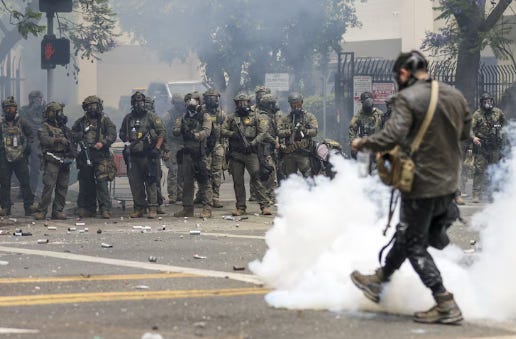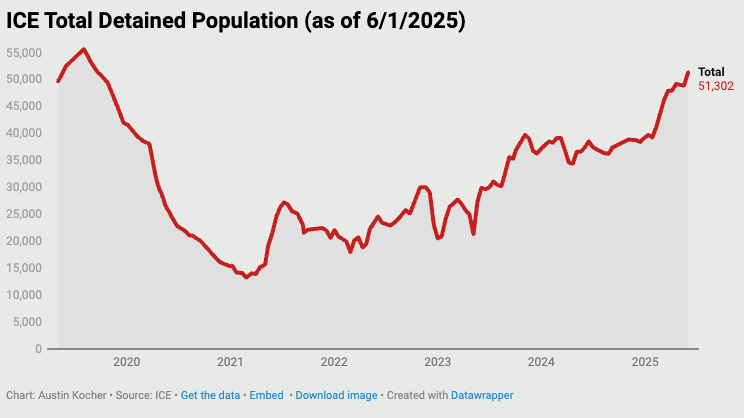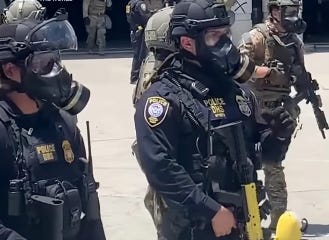In 2023 Russell Vought described the legal hurdles the Trump administration faced in its first term, when he for six months was director of the Office of Management and Budget. The next time, he told an invitation-only gathering at his think tank, the Center for American Renewal, the Trump administration would be ready. Already the think tank was “trying to build a shadow Office of Legal Counsel”—
so that when a future president says, ‘What legal authorities do I need to shut down the riots?’, we want to be able to shut down the riots. And not have the legal community or the defense community come in and say, ‘That’s inappropriate use of what you’re trying to do.’
On Saturday, June 7, confrontations broke out in the predominantly Latino suburb of Paramount, south of downtown Los Angeles. From a DHS office, federal agents were staging another day of sweeps. Already agents had rounded up more than 100 immigrants for detention. The day before they raided a retail and distribution warehouse in the downtown Fashion District and arrested immigrants as they came to scheduled check-ins or made courthouse appearances. Daughters watched their fathers led from jobs in handcuffs. An 8-year-old son watched ICE arrest his father. Families were breaking apart. The LA Unified School District named four schools reporting ICE activity, including elementary schools, and at least one elementary student and his father were set for deportation.
The Trump administration’s talk around deporting violent criminals didn’t ring true in the working-class immigrant community of Paramount. “This whole rhetoric of coming after hardworking families is what we are all concerned about,” said California Assemblymember José Luis Solache Jr., who represents Paramount. “When you come to do raids at businesses, that is where the anger comes from.”

Such communities have long been lobbying for legal pathways for undocumented residents who are law-abiding and hard-working to remain in the United States, but Congress for decades now has reneged on immigration reform.
Word spread on social media when border patrol agents wearing balaclavas and tactical gear were spotted across the street from the Home Depot about 9 a.m. Passersby honked their horns, and soon protesters arrived (Andor, anyone?). They hauled trashcans to light piles of trash in the streets and threw rocks at Border Patrol vehicles. Agents drew their rifles, unleashed tear gas, flash-bang explosives, and pepper balls. There was never a raid at the Home Depot in Paramount, but the store eventually closed.
As protests continued into the evening with cars set on fire and smoke billowing, Los Angeles police—soon joined by the county sheriff’s department and California Highway Patrol—declared the protests unlawful and sent reinforcements, including helicopters that warned those in the street they would be arrested. One federal agent was reported injured by rocks thrown.
In Washington, President Donald Trump ordered 2,000 National Guard troops to L.A. on Saturday evening—unconstrained by legal eagles as he was during 2020 George Floyd protests. Russell Vought, now OMB head again and architect of mass federal firings and restructuring, and others had seen to that.
The president then headed to New Jersey for the UFC championship fight. He entered the arena late Saturday evening to thunderous applause and was joined by his daughter Ivanka Trump and her husband Jared Kushner, son Eric Trump, and Secretary of State Marco Rubio.
By Sunday President Trump commandeered 2,000 members of California’s National Guard and placed them under federal control, bypassing the opposition of state leaders. He also sent another 2,000 National Guard troops and 700 Marines to the greater Los Angeles area. California’s attorney general sued the Trump administration on Monday, and a federal judge said the president violated the U.S. Constitution, ordering Trump to relinquish control of the state Guard troops deployed in L.A. But an appeals court put the order on hold today, with a hearing scheduled for Tuesday—after protests scheduled in several cities over the weekend and a military parade on Saturday in Washington, D.C.
It’s unusual for active duty military personnel to be deployed in response to a domestic protest—and with seasoned local law enforcement already in place. The last time it happened was in 1965, when President Lyndon Johnson bypassed Gov. George Wallace on the eve of the Selma march in Alabama.
When President George H. W. Bush deployed the Guard to Los Angeles during Rodney King riots in 1992, the situation was far different, and the governor requested federal assistance. See the Times graphic showing the varied law enforcement agencies staking their ground in L.A., seven days into protests and with a curfew in place.
The unrest also grew out of White House action. The Wall Street Journal reports that the stepped-up ICE raids are part of a directive from Trump deputy chief of staff Stephen Miller, who urged agents to “just go out there and arrest illegal aliens,” including at 7-Elevens and Home Depots.
Across the country large-city mayors worry about more raids and national intervention that could escalate immigration challenges and threats of violence. But most Republicans in Congress believe sending troops was justified in L.A.’s case.
The show of force helps the administration build a case for its budget bill before Congress that includes $155 billion in new immigration enforcement funding—more than five times the amount of current funding. Yet despite planeloads of immigrants taken across the country and overseas, the Trump administration has been falling short compared to daily deportations carried out by the Biden administration in its final year.
As of last week, that’s changing, according to immigration researcher Austin Kocher.
As Kocher points out, the largest growth in ICE’s detained population over the past two weeks comes from people who have no criminal charges or convictions on their record.
Most countries in the world have a national police force, but the United States has stood out for its well-placed value on local law enforcement, who are best adept at knowing local conditions and their own populations.
Reporting from military embed assignments in Iraq and Afghanistan, I’ve seen how even in war zones national forces (and the U.S. military) can actually threaten security and be oblivious to local needs. (One example: Jamming devices that became standard issue on up-armored vehicles could knock out cell service for whole business districts and neighborhoods.)
Without a stake in the community, the outsiders become the enemy and treat those they should be protecting as opponents. Violence tends to rise, and a police state once hatched is hard to roll back. Seeing masked federal agents with weapons raised on a Saturday morning in America, knowing what it portends in wartime overseas, I found chilling.
DHS police, part of Homeland Security’s Federal Protective Service, began with a mandate to protect federal property that’s morphed in recent years into a behemoth force with expansive authority, few boundaries, and little oversight, reports the Brennan Center:
In fiscal year 2024 alone, FPS spent approximately $1.7 billion on contract guards, more than 76 percent of its total budget. Constellis Group, the security conglomerate formed from the merger between defense contractor Triple Canopy and the company formerly known as Blackwater, today holds FPS’s largest contracts, valued together at $225 million or more. The two organizations, fixtures of the global war on terror, have been plagued by scandal.
My friend Kaitlyn Schiess has some thoughts about matching convictions with protesting well.
The number of foreign-born people either working or looking for work fell by about 1 million from March to May, and latest jobs reports are starting to show how the immigration crackdowns will affect the U.S. labor market.
Over and over, Vought and others in the Trump administration exaggerate problems to justify outsized intervention. It’s a way to find cover, too, when the cure proves worse than the disease.
Other news of the week:
Overnight Israel launched strikes against key military targets in Iran, and strikes on its primary nuclear facilities, including Natanz and Isfahan, are continuing today.
Prime Minister Benjamin Netanyahu said earlier today, “We struck at the heart of Iran’s nuclear enrichment program,” and he said the operation would continue “for as many days as it takes” to remove Iran’s threat. According to Iranian media, the attacks also targeted top scientists and generals, including the chief of staff for Iran’s Islamic Revolutionary Guard Corps and others.
The IAEA, the UN’s nuclear monitored, reported no leaks of radioactive material from Natanz but warned against further attacks.
President Trump told the Wall Street Journal he knew the attacks were coming. Trump had set the stage, pressing Tehran for a new deal limiting its nuclear enrichment program and giving the Islamic regime a 60-day window to come to terms. Today, he said, was the 61st day.
Hezbollah blames US forces in Iraq for paving “the way for this aggression by opening Iraqi airspace” and providing passage to Israeli jets. It called on Baghdad to expel “foreign forces.” Seasoned analysts say Israel had to have a green light from U.S. Central Command, and even as some call this a “good deed,” it’s too early to say. Once started, wars have a way of not stopping in the Middle East.
In the West Bank, Israel imposed a lockdown on Palestinian cities and villages, shutting down all checkpoints and iron gates Palestinians use to get to work in Israel in conjunction with attacks on Iran.
Russia launched record drone strikes this week, including one that struck historic St. Sophia Cathedral in Kyiv, attacking civilian targets in response to Ukraine’s attacks on its military installations a week ago. The Trump administration last night informed Congress that it has approved a proposed transfer of “major defense equipment” worth $30 million for Ukrainian forces, according to the Kyiv Post.
The 11th century St. Sophia, considered the “soul of Ukraine” and a UNESCO World Heritage site, saw the cornice of its central apse and its sanctuary damaged. A statement from the Ukrainian Council of Churches said Russian forces have “no regard for the sacred” and noted:
Since the beginning of Russia’s full-scale invasion, 670 churches and houses of worship have been destroyed or damaged. Sixty clergy members from various churches and religious organizations have been murdered by Russian invaders. Many priests and pastors have been illegally arrested and held in Russian captivity.
From his hospital bed in Ahmedabad, Air India Flight 171’s sole survivor said he doesn’t know how he survived the crash that killed 241 passengers and crew members plus dozens more on the ground. Viswashkumar Ramesh, a British national, limped from the wreckage after seeing an opening where his side of the plane landed into a hostel building.
The U.S. House on Thursday approved a measure, 214-212, to ‘clawback’ $9.4 billion in spending that lawmakers had approved for foreign aid and public broadcasting. The vote formalized cuts made unilaterally by the Trump administration, which made a formal request for the measure. They include all federal funding for PBS and NPR, $1.7 billion, plus took the largest bites overseas out of PEPFAR and other funding for HIV/AIDS programs, and funding for humanitarian disaster relief.
Worldwide more than 122 million people have been displaced by war and persecution, UN figures released this week show. Despite millions of Syrians returning to their homes following the downfall of the Assad government, an additional 2 million people globally have been forced from their homes from one year ago. At the same time, funding levels this year for refugees have fallen to 2015 levels, when the number displaced was half what it is now, about 60 million.
On the homefront, I’m launching into Ron Chernow’s new biography of Mark Twain, seeing some GlobeTrot friends and hoping for lobster as I head out for a week’s vacation. Paid subscribers may see a post sooner, but expect a news summary to return June 27.
Peace is not the absence of conflict, writes Stanley Hauerwas. “Rather, peacemaking is the quality of life and the practices engendered by a community that knows it lives as a forgiven people.”





